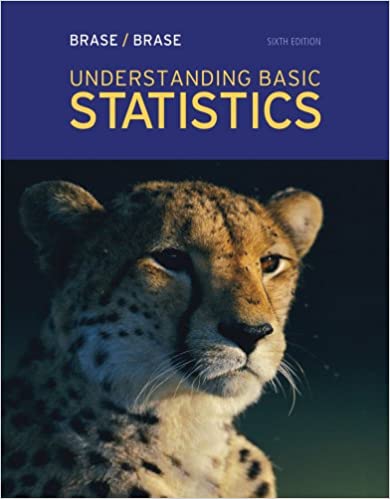
Understanding Basic Statistics 6th Edition by Charles Henry Brase,Corrinne Pellillo Brase
Edition 6ISBN: 978-1111827021
Understanding Basic Statistics 6th Edition by Charles Henry Brase,Corrinne Pellillo Brase
Edition 6ISBN: 978-1111827021 Exercise 77
Use the following steps (i)-(v) for all hypothesis tests:
(i) What is the level of significance State the null and alternate hypotheses.
(ii) Check Requirements What sampling distribution will you use What assumptions are you making What is the value of the sample test statistic
(iii) Find (or estimate) the P -value. Sketch the sampling distribution and show the area corresponding to the P -value.
(iv) Based on your answers in parts (i)-(iii), will you reject or fail to reject the null hypothesis Are the data statistically significant at level a
(v) Interpret your conclusion in the context of the application.
Note: For degree of freedom d.f. not in the Student's t table, use the closest d.f. that is smaller. In some situations, this choice of d.f. may increase the P -value a small amount and thereby produce a slightly more "conservative" answer.
Essay and Project In Chapters 8 and 9 you studied estimation and hypothesis testing.
(a) Write a brief essay in which you discuss using information from samples to infer information about populations. Be sure to include methods of estimation and hypothesis testing in your discussion. What two sampling distributions are used in estimation and hypothesis testing of population means and proportions What are the criteria for determining the appropriate sampling distribution What is the level of significance of a test What is the P -value How is the P -value related to the alternate hypothesis How is the null hypothesis related to the sample test statistic Explain.
(b) Suppose you want to study the length of time devoted to commercial breaks for two different types of television programs. Identify the types of programs you want to study (e.g., sitcoms, sports events, movies, news, children's programs, etc.). Write a brief outline for your study. Discuss how to obtain random samples. How large should the sample be for a specified margin of error Describe the protocol you will follow to measure the times of the commercial breaks. Determine whether you are going to compare the average time devoted to commercial or the proportion of time devoted to commercial. What assumptions will you make regarding population distributions What graphics might be appropriate What methods of estimation will you use What methods of testing will you use
(i) What is the level of significance State the null and alternate hypotheses.
(ii) Check Requirements What sampling distribution will you use What assumptions are you making What is the value of the sample test statistic
(iii) Find (or estimate) the P -value. Sketch the sampling distribution and show the area corresponding to the P -value.
(iv) Based on your answers in parts (i)-(iii), will you reject or fail to reject the null hypothesis Are the data statistically significant at level a
(v) Interpret your conclusion in the context of the application.
Note: For degree of freedom d.f. not in the Student's t table, use the closest d.f. that is smaller. In some situations, this choice of d.f. may increase the P -value a small amount and thereby produce a slightly more "conservative" answer.
Essay and Project In Chapters 8 and 9 you studied estimation and hypothesis testing.
(a) Write a brief essay in which you discuss using information from samples to infer information about populations. Be sure to include methods of estimation and hypothesis testing in your discussion. What two sampling distributions are used in estimation and hypothesis testing of population means and proportions What are the criteria for determining the appropriate sampling distribution What is the level of significance of a test What is the P -value How is the P -value related to the alternate hypothesis How is the null hypothesis related to the sample test statistic Explain.
(b) Suppose you want to study the length of time devoted to commercial breaks for two different types of television programs. Identify the types of programs you want to study (e.g., sitcoms, sports events, movies, news, children's programs, etc.). Write a brief outline for your study. Discuss how to obtain random samples. How large should the sample be for a specified margin of error Describe the protocol you will follow to measure the times of the commercial breaks. Determine whether you are going to compare the average time devoted to commercial or the proportion of time devoted to commercial. What assumptions will you make regarding population distributions What graphics might be appropriate What methods of estimation will you use What methods of testing will you use
Explanation
(a) Samples are the backbone of statisti...
Understanding Basic Statistics 6th Edition by Charles Henry Brase,Corrinne Pellillo Brase
Why don’t you like this exercise?
Other Minimum 8 character and maximum 255 character
Character 255


